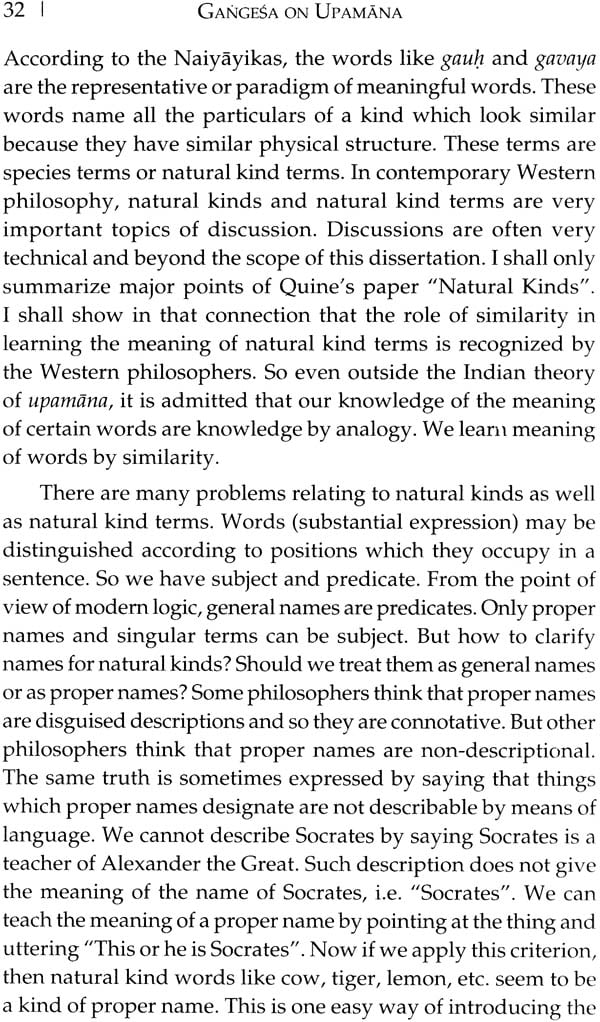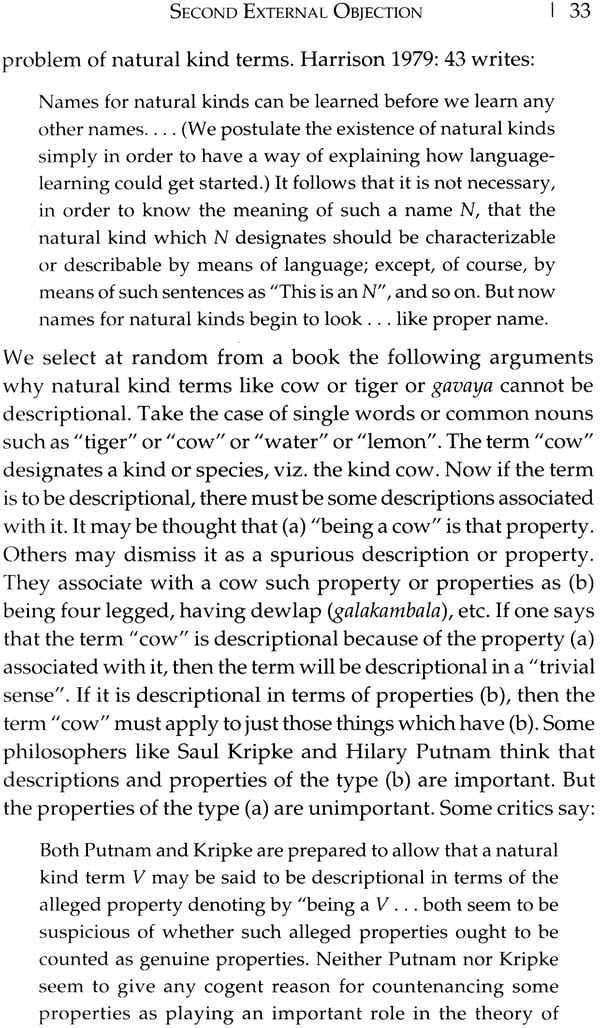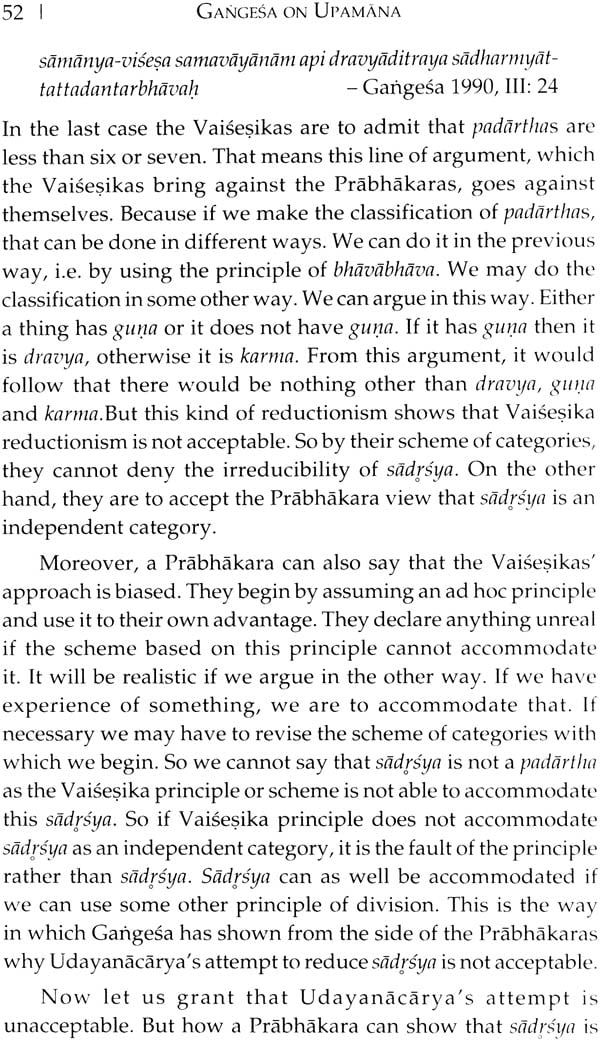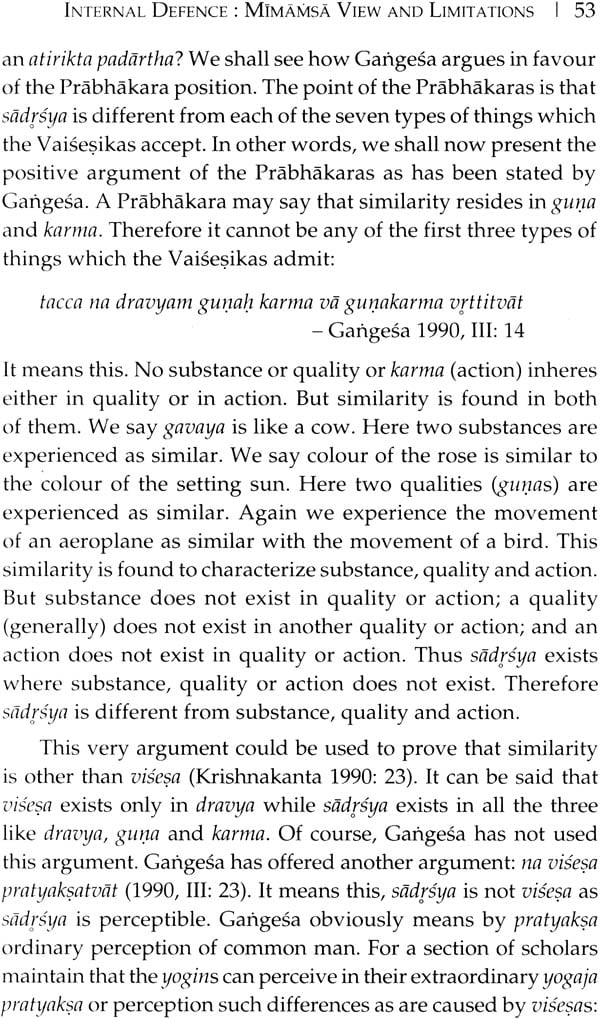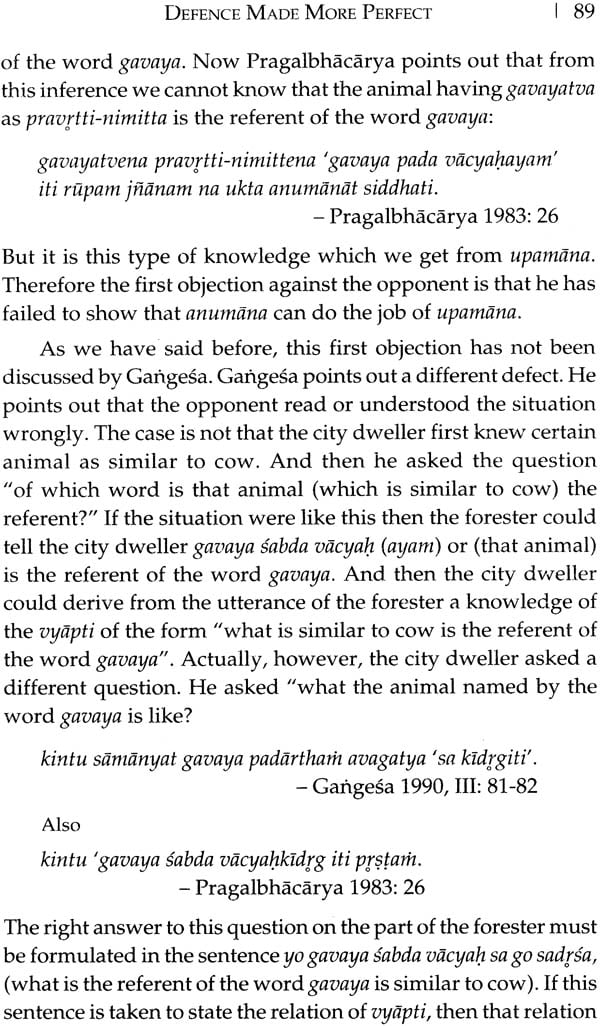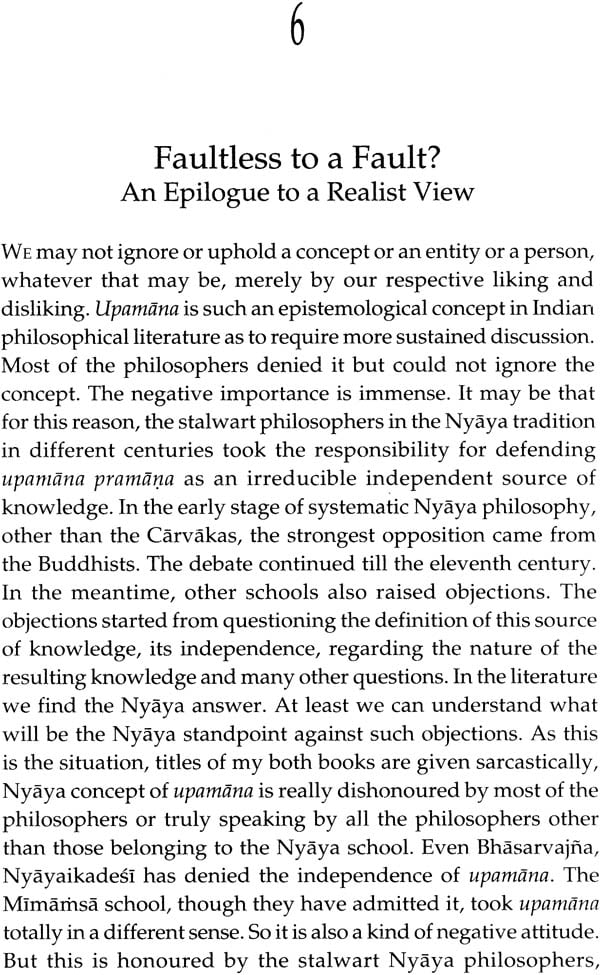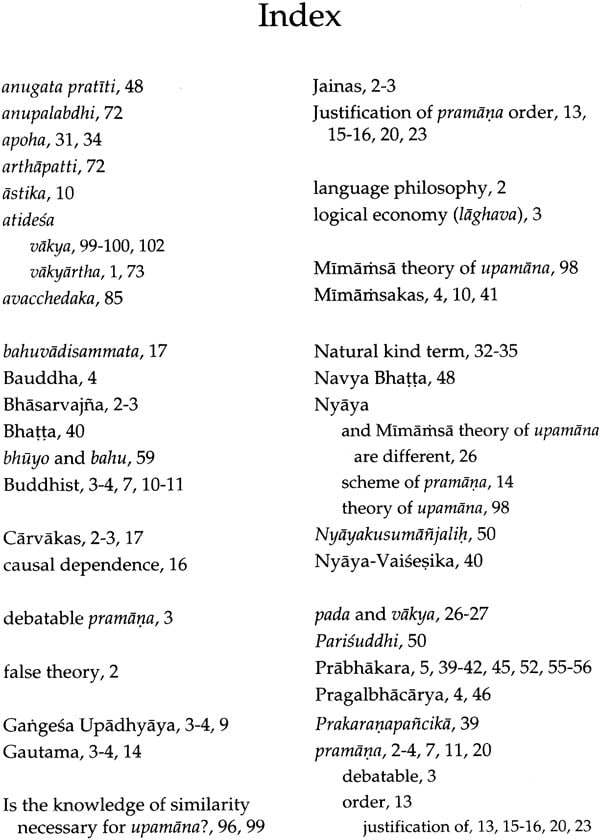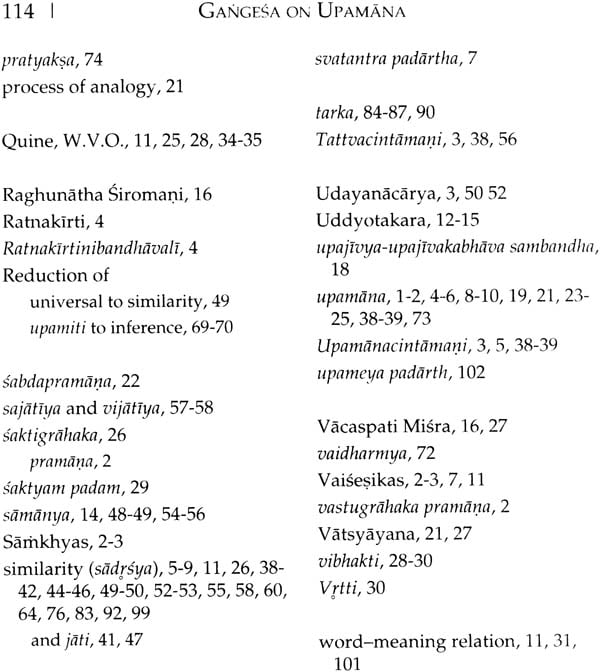
Gangesa on Upamana in Indian Epistemology (Faultless to a Fault)
Book Specification
| Item Code: | NAK707 |
| Author: | Uma Chattopadhyay |
| Publisher: | D. K. Printworld Pvt. Ltd. |
| Language: | English |
| Edition: | 2015 |
| ISBN: | 9788124608173 |
| Pages: | 128 |
| Cover: | Hardcover |
| Other Details | 8.5 inch X 5.5 inch |
| Weight | 340 gm |
Book Description
The present volume is a sequel to the author's previous work entitled Dishonoured by Philosophers: Upamana in Indian Epistemology (2009) where she introduced the notion of upamana, its definition, process and also its status in Indian epistemology in general and the Nyaya school in particular. The book ended with an exposition of Udayanacarya, an eleventh-century Nyaya philosopher. But the debate did not end there. Many Indian philosophers took the hard task of reducing upamana to other pramanas, and there were other objections as well.
The sequel volume is a logical and historical extension of the arguments made in defence of upamana in the previous work. An interesting feature of the continuing debate is that a large number of Indian philosophers including the Bauddhas, Jainas, Samkhyas, Vaisesikas, Mimarnsakas, Carvakas and even individual Naiyayikas such as Bhasarvajna were still doubtful of the status of upamana. Over and above all, there was the question of logical economy in a scheme of pramanas. The present work for the first time provides an intensive study of how the Indian philosopher Gangesa Upadhyaya took up the challenge in the twelfth century to give upamana a definite, irreducible place in the scheme of pramanas. Based on Gangesa's monumental work Upamanacintamani along with Pragalbhacarya’s celebrated commentary on it, the author reopens the question of upamana in a dialogical method and tries to measure the perfection of Gangesa's arguments. She upholds Gangesa's standpoint as the height of perfection, the most vigorous defence of upamana in a series of defences and objections in a long course, and titles this task of Gangesa Faultless to a Fault in her book.
Uma Chattopadhyay has been teaching philosophy at the graduate and post-graduate levels for over thirty years. Educated at Jadavpur University, she earlier taught at many colleges including Bethune College and Lady Brabourne College, Kolkata. She joined at the Department of Philosophy, University of Calcutta in 2005, where she is currently Professor of Philosophy. She participated in many national and international seminars in various parts of India, and extensively published in academic journals and anthologies. She was a Fellow in Maison des Sciences de 1'Homme, Paris and delivered lectures at Uppsala University, Sweden. She has a wide range of research interests: Indian epistemology, metaphysics, philosophy of language, philosophy of religion and ethics. Her other published monograph is Dishonoured by Philosophers: Upamana in Indian Epistemology (2009).
IT is by the ahaituki krpa of my mother Ananandamayee that I could complete the book, Faultless to a Fault: Gangesa on Upamana in Indian Epistemology. I had to cross many hurdles including the sudden demise of my elder and only sister Gouri Mukherjee very recently on 17 May 2014. I cannot think about my family, past and present, without my dearest did/. There was a great vacuum in my life. With a heavy heart, I had to come back to the work of finishing this book. I had been deeply involved in the study and understanding of Indian philosophy from the early stages of my academic career and had a rare opportunity to study many branches of it including the Nyaya system from stalwarts like Prof. Pradyot Kumar Mukhopadhyay, Prof. Kali Krishna Banerjee, Prof. Srilekha Dutta, Prof. Krishna Roy, Pandit Pancanan Sastri, Pandit Narmada Tarkatirtha, Prof. Tapan Kumar Chakraborty, Prof. Sukhoranjan Saha and many other eminent teachers of the philosophy world. How much knowledge I acquired from them I do not know; at least what I gained from them is to love Indian philosophy and culture of this nation. And my commitment to this tradition came from them, I believe.
The ability of Indian philosophers to understand the depth of a problem and their potential to resolve the same are amazing to me. What I learned from my teachers was to address a problem applying both Indian and Western philosophies. It is a rare kind of inspiration that I got from the academia of Jadavpur University's philosophy department. I have to acknowledge the contribution from an illustrious teacher Prof. Pranab Kumar Sen. He always inspired us by saying "You have to play in the field, going beyond merely watching and making comments on others". This was really a valuable advice for me. Guided by such stimulated advices and due to my deep love for studies in the Nyaya tradition, I started the work on Gangesa's Upamanacintamani, a part of his monumental work Tatitacintamani, though knowing fully that I was not competent enough to understand thoroughly a Navya-Nyaya philosopher like Gangesa Upadhyaya. Then why and how did I come to understand Gangesa?
In my undergraduate course, I was surprised to notice a problem regarding upamana pramana (knowledge by comparison) besides many other problems of Indian and Western philosophies. While studying Udayanacaryas Nyayakusumanjalih in my post-graduate course, I was surprised to see that both the Nyaya and Mimamsa systems are accepting this source of knowledge but totally in two different senses. After completing my Master's, I got the rare opportunity of doing Ph.D. under the guidance of Prof. Pradyot Kumar Mukhopadhyay. I changed my initial research topic on Indian scepticism (aprama) and took finally upamana as topic for my research. I immediately realized that under his able guidance I will be able to swim (at least to some extent) in the ocean of philosophy. It took a long time, but I could complete my research in the mid-1990s. The subject was vast as I considered all the schools of Indian tradition in the context of upamana. I developed the first part of my work and later made it a publication Dishonoured by Philosophers: Upamana in Indian Epistemology where I have discussed the debates between Nyaya-Bauddha, Nyaya-Vaisesika and also Nyaya-Mimamsa etc.
Historically I have made a story on upamana from Gautama to Udayanacarya (the story from the fifth to the eleventh century CE) regarding the issue of upamana. Of course, the development is mainly logical, but to some extent historical. I ended the research dissertation with the view of Gangesa on upamana. It is really a brilliant feature that most of the philosophers including some Nyaya-Vaisesikas have either shown indifference or raised objections and showed that Nyaya position is faulty but all the three stalwart philosophers of the Nyaya tradition ranging from the fifth to the twelfth century - Gautama, Udayanacarya and Gangesa - are given much importance to the problem of upamana. Final faultless position is shown by Gangesa. Gautama and Udayanacarya are comparatively lighter than Gangesa. I had to complete the story of upamana (with the help of my teacher and with my very limited capacity) by Gangesa.
In my previous book I could not include Gangesa's view on upamana but I thought that if possible I might prepare another dissertation on upamana where Gangesa would be focused. The text Upamanaciniamani is very hard and full of Navya- Nyaya technicalities; so I have tried to present Gangesa not by literal translation but only the idea of Gangesa in today's language. This is to complete a story and to show how much the philosophers of Indian soil are committed to their own tradition, which is full of rationality. So presentation of Gangesa is not only the outcome of my emotions but is academically argued. This is actually a continuation of the first book. I have only tried to make a gateway to the future researchers on Indian philosophy. I have presented Gangesa in two chapters. But before that and before giving Gangesa's final answer, one external objection is raised in the first chapter, i.e. insertion of upamana makes the scheme of pramanas anomalous. It would have been better if Gautama or Gangesa could delete upamana from their scheme of pramanas. I have given an alternative answer and finally a positive answer in favour of the Nyaya position.
I am happy that I could complete this book after five years of publishing of my first book. I am late as I was heavily engaged in my departmental activities. As an acting coordinator I had to take responsibilities of many publications and UGC-5AP- DR5 programmes, and my personal academic programme of publication was postponed. My desire was immense but possibility of giving shape to it was disturbed. I had to accept the delay.
The fact that I could complete the present work was made possible by the direct and indirect contributions of many. The foremost among them is my husband Arun Bandyopadhyay, who currently holds Nurul Hasan Chair Professor of History at the University of Calcutta. He first suggested the idea of completing this book on Gangesa as a search for perfection in our arguments for upamana - faultless to a fault. But his constant pestering for finishing the book was creating a kind of nervousness in me. It is only because of him that I could prepare this book. He is always positive for my academic pursuits. I always believe if research is one step, publishing it is another step. I was reluctant to take the second step; it is only for Arun that I have crossed the second step and the idea of Gangesa in the present form could see the light of the day.
This time I am deeply indebted to my very dear daughter- in-law Amrita (Manorama) and my son Manasij (Bapan). Their peaceful, enjoyable and creative life is a real inspiration for me. I can do many positive things when they are happy. My daughter-in-law even went further and used to ask me the question whether her telephone call from England was creating disturbance to my studies. A computer engineer by profession, she has always appeared beautiful and nice to me. Her finer senses are really attractive and much inspiring. May God bless them for their health and good soul. Her father Shri Gautam Bhattacharya (Bhaiti), mother Smt. Bhaswati Bhattacharya (Deepsikha) and younger sister Arpita (Mimburi) are my constant inspiration in academic journey. I am really grateful to them. I am immensely indebted to them in many ways. May God bless us for this beautiful bonding.
The five other young stars - Bishnupriya (a very good classical vocalist), Nandini, Anindita, Somapriya and Ayanika - have always worked as sources of inspiration. And they are full of qualities and stand always by my side in different ways. They know how much valuable is their inspiration for me and in which way they can all help me. I am also happy with the kids of my family. They are my inspiration. They are Baby Queen, Ganubhai, Gunudidi, Gopal and Gadadhar. My two sister-in-laws, Didibhai (Amita Chakraborty) and Baby (Anindita Chatterjee), are always with me. I could make myself more creative by their sweet presence in my life. My another extended sister Mitra, despite our infrequent meetings in recent times, silently make a positive presence in my life. I do always cherish her company.
By the help and support from the domestic ladies - Roma, Anita and Seema - I could take much time from the regular household works.
My indebtedness to Mrs Tapati Mitra is immense. Her meticulous typing with the diacritical mark is really praiseworthy. I pray blessings of my mother for her and for her beautiful family.
I cannot thank my teacher, Prof. Pradyot Kumar Mukhopadhyay; so I take this opportunity to convey my pranama to him. I beg his blessings which will help me in every way.
I am immensely grateful to our Hon'ble Vice-Chancellor Prof. Suranjan Das. His academic inspiration is unforgettable. I feel proud when I see a dynamic personality like Prof. Das is leading the University of Calcutta for its academic excellence.
Some of the portions of the present work I presented in refresher courses, orientation programmes, and seminars in different universities and colleges and the feedback that I received is really unforgettable. That made me to think and re-think on different issues particularly on the issue of similarity, place of upamana in the scheme and also regarding the independent status of upamana in the scheme of pramana. My thanks to all such participants of refresher courses and orientation programmes. We not only teach in the courses, we learn immensely from them. So I am obliged to the participants, to the directors of academic staff colleges, and the coordinators of such programmes and the organizers of different seminars.
I am very happy with the production of my previous book by Shri Susheel Mittal of D.K. Printworld (Delhi). So this time also I wanted him to take up the responsibility. D.K. Printworld's ethics and production method are really amazing. Distance is not at all a factor for a good job. This is proved by the dedication of Shri Susheel Mittal and his company D.K. Printworld. I am happy and deeply obliged to him.
I cannot convey my thanks to my Ph.D. scholars, but I can convey my blessings for their academic support which they have given in their own way. I need to mention specially the name of Mr Siddique Alam Beg, my Ph.D. scholar. He was all the time ready to bring books from different corners. May God bless him for his academic enthusiasm.
My close neighbours Krishna and Kanchan are always with me and have very much inspired me for my academic and professional activities. I am grateful to them for their positive role.
There are many colleagues in my department and in the other departments with whom I made my academic communications that enriched myself. Of them, special mention can be made of Dr Sharmistha Bakshi, Dr Krishna Chatterjee, Prof. Subirranjan Bhattacharya, Prof. Manidipa Sanyal, Prof. Nini Chanda, Prof. Aparna Banerjee, Prof. Priyambada Sarkar, Prof. Dilip Kumar Mohanta, Dr Shilpita Mitra, Dr Shyamasree Bhattacharya, Dr Mahjabeen Jahan, Dr Pralayankar Bhattacharyya and Smt. Sunanda Das and many others. I must also mention the names of Prof. Indrani Sanyal of the Department of Philosophy, Jadavpur University, and Prof. Amarnath Bhattacharya, retired professor of philosophy, Burdwan University who have always enlightened me by their brilliant observations, communications and conversations. I always enjoy teaching, so the past and the present students influence me in my thought process. I convey my blessings to them all.
| Preface | vii | |
| 1 | Setting the Theme: Upamana's Journey from Many Faults to the Faultless | 1 |
| 2 | First Eternal Objection: Anomalous Nyaya Scheme of Pramanas | 10 |
| 3 | Second External Objection: No Use of Similarity Outside Philosophy | 24 |
| 4 | The Internal Defence: The Mimamsa View and Its Limitations | 38 |
| 5 | The Defence Made More Perfect: Gangesa's Lasting Contribution on Upamana | 68 |
| 6 | Faultless to a Fault?: An Epilogue to a Realist View | 94 |
| Bibliography | 105 | |
| Index | 113 |
